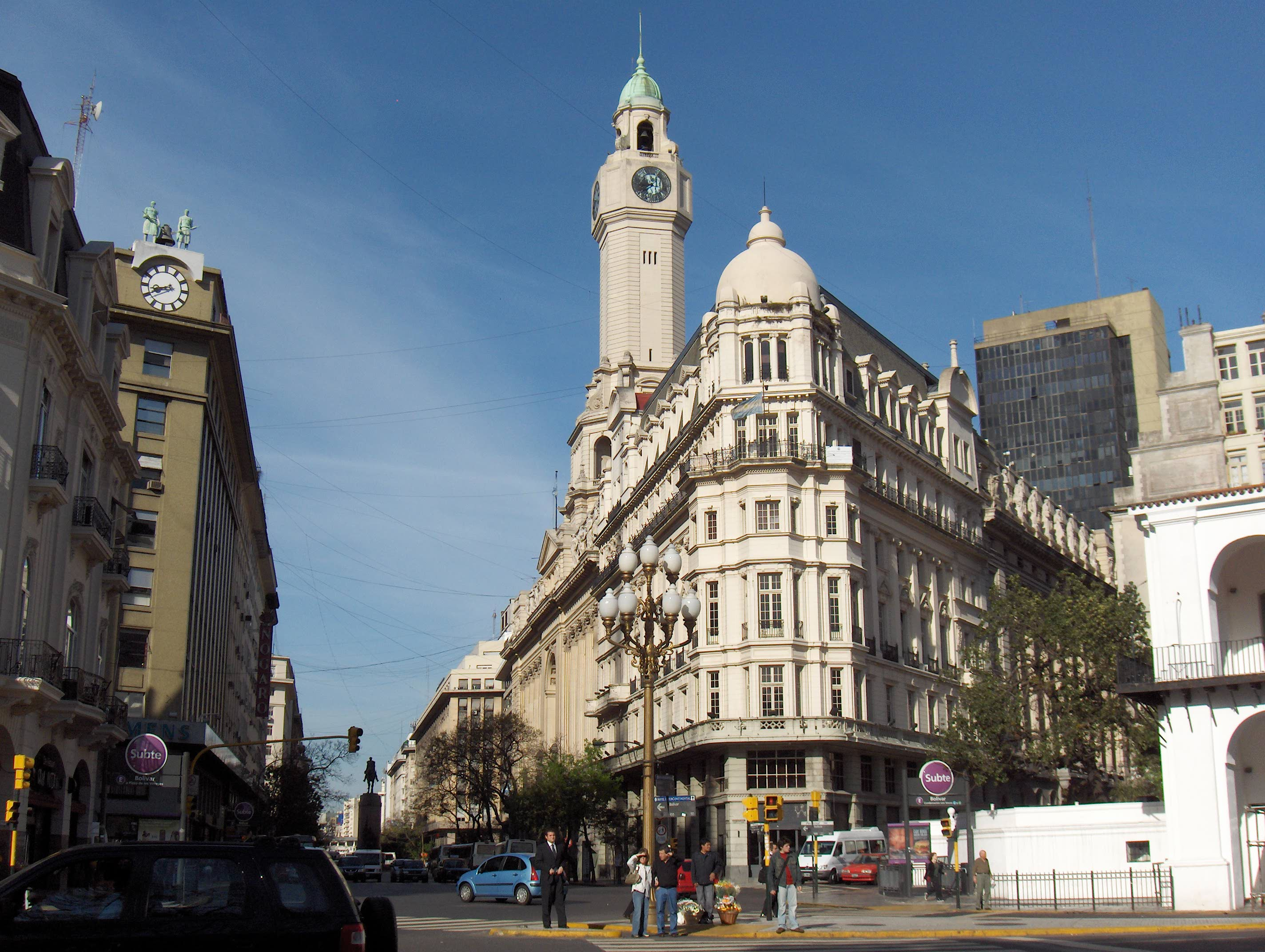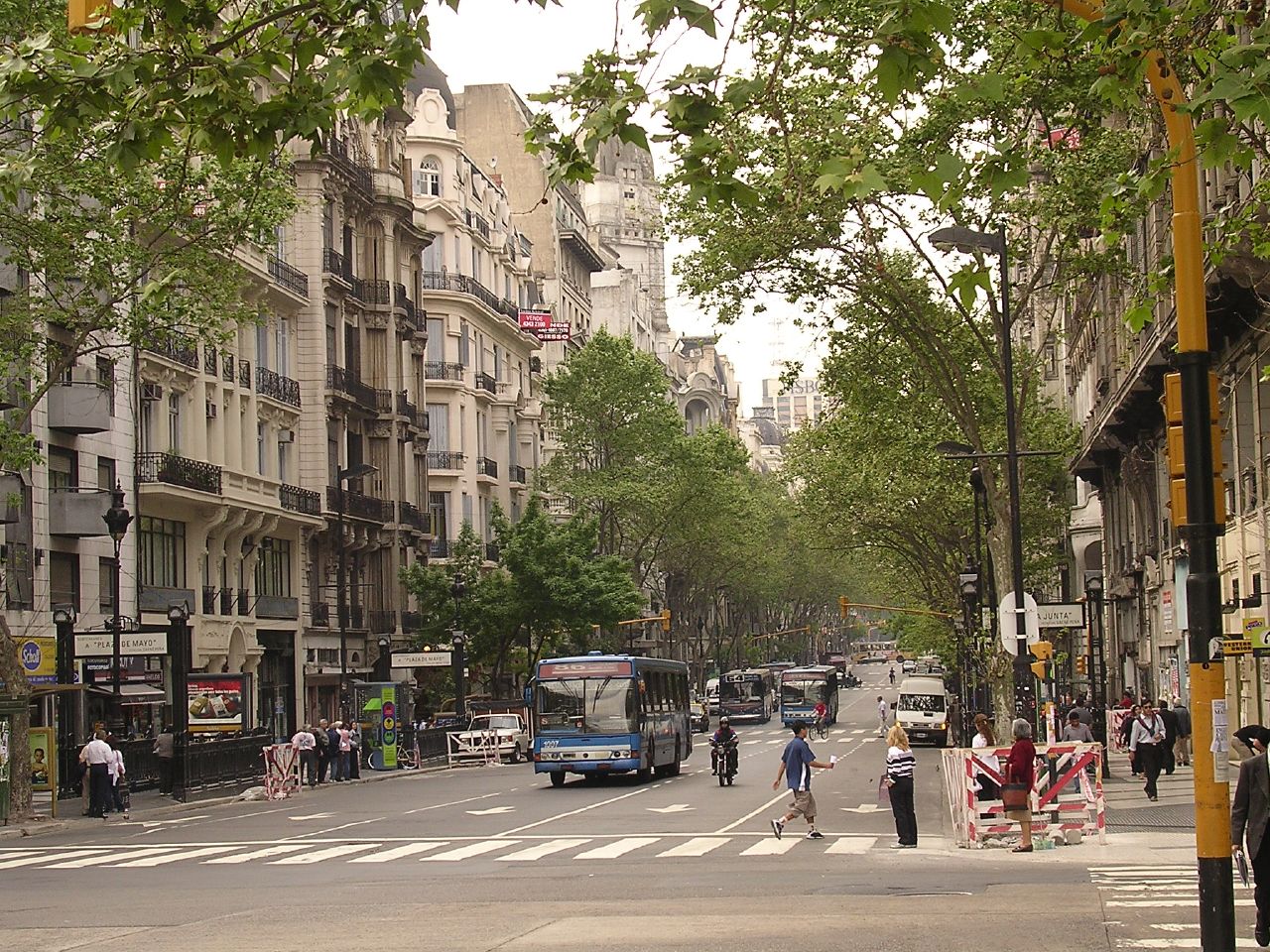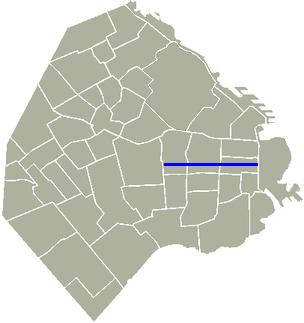|
Iglesia Presbiteriana San Andrés (Centro)
Iglesia Presbiteriana San Andrés del Centro (St. Andrew's Scotch Presbyterian Church) is a Presbyterian temple of the city of Buenos Aires. It is located in the vicinity of Otto Wulff building, neighborhood of Monserrat. History Originally this church was founded to assist the Scottish community of Buenos Aires, being his first Minister William Brown, who was in charge until 1850. The ancient temple was located on Piedras Street, current Avenida de Mayo, neighborhood of Monserrat. Towards 1890 began the works for the construction of a new temple located on Avenida Belgrano, between Peru and Bolivar Streets. The project was entrusted to the British architects, Edwin Arthur Merry and Charles Raynes, who completed the work in 1896. The original tower was demolished in 1950 due to the widening of Belgrano Avenue. His current facade dates from 1962. Iglesia Presbiteriana San Andrés began to offer services in Spanish since 1912, charge that was entrusted to Minister José Felice ... [...More Info...] [...Related Items...] OR: [Wikipedia] [Google] [Baidu] |
Presbyterian
Presbyterianism is a part of the Reformed tradition within Protestantism that broke from the Roman Catholic Church in Scotland by John Knox, who was a priest at St. Giles Cathedral (Church of Scotland). Presbyterian churches derive their name from the presbyterian polity, presbyterian form of ecclesiastical polity, church government by representative assemblies of Presbyterian elder, elders. Many Reformed churches are organised this way, but the word ''Presbyterian'', when capitalized, is often applied to churches that trace their roots to the Church of Scotland or to English Dissenters, English Dissenter groups that formed during the English Civil War. Presbyterian theology typically emphasizes the sovereignty of God, the Sola scriptura, authority of the Scriptures, and the necessity of Grace in Christianity, grace through Faith in Christianity, faith in Christ. Presbyterian church government was ensured in Scotland by the Acts of Union 1707, Acts of Union in 1707, which cre ... [...More Info...] [...Related Items...] OR: [Wikipedia] [Google] [Baidu] |
Monserrat, Buenos Aires
Monserrat or Montserrat () is a neighbourhood in the east of the Buenos Aires CBD. The district features some of the most important public buildings in Buenos Aires, including city hall, the city legislature, Casa Rosada, the Colegio Nacional de Buenos Aires and the Libertador Building (Ministry of Defense), among others. Avenida de Mayo runs through the Monserrat district, connecting Plaza de Mayo and the Plaza de los Dos Congresos (Congressional Plaza). A block, or two, south of the Plaza de Mayo, the older section of Monserrat begins. This is Buenos Aires' oldest neighborhood and even today, very little of the cityscape there is less than a hundred years old (except along Belgrano Avenue), thereby making a nearly seamless transition to the likewise historic San Telmo district, to the south. History The Monserrat area traces its origins to the foundation of Buenos Aires itself, when, in 1580, Spanish Adelantado Juan de Garay disembarked on the area's shores. The Fort ... [...More Info...] [...Related Items...] OR: [Wikipedia] [Google] [Baidu] |
Protestantism
Protestantism is a branch of Christianity that follows the theological tenets of the Protestant Reformation, a movement that began seeking to reform the Catholic Church from within in the 16th century against what its followers perceived to be growing errors, abuses, and discrepancies within it. Protestantism emphasizes the Christian believer's justification by God in faith alone (') rather than by a combination of faith with good works as in Catholicism; the teaching that salvation comes by divine grace or "unmerited favor" only ('); the priesthood of all faithful believers in the Church; and the ''sola scriptura'' ("scripture alone") that posits the Bible as the sole infallible source of authority for Christian faith and practice. Most Protestants, with the exception of Anglo-Papalism, reject the Catholic doctrine of papal supremacy, but disagree among themselves regarding the number of sacraments, the real presence of Christ in the Eucharist, and matters of ecclesiast ... [...More Info...] [...Related Items...] OR: [Wikipedia] [Google] [Baidu] |
Argentina
Argentina (), officially the Argentine Republic ( es, link=no, República Argentina), is a country in the southern half of South America. Argentina covers an area of , making it the second-largest country in South America after Brazil, the fourth-largest country in the Americas, and the eighth-largest country in the world. It shares the bulk of the Southern Cone with Chile to the west, and is also bordered by Bolivia and Paraguay to the north, Brazil to the northeast, Uruguay and the South Atlantic Ocean to the east, and the Drake Passage to the south. Argentina is a federal state subdivided into twenty-three provinces, and one autonomous city, which is the federal capital and largest city of the nation, Buenos Aires. The provinces and the capital have their own constitutions, but exist under a federal system. Argentina claims sovereignty over the Falkland Islands, South Georgia and the South Sandwich Islands, and a part of Antarctica. The earliest recorded human prese ... [...More Info...] [...Related Items...] OR: [Wikipedia] [Google] [Baidu] |
Andrew The Apostle
Andrew the Apostle ( grc-koi, Ἀνδρέᾱς, Andréās ; la, Andrēās ; , syc, ܐܰܢܕ݁ܪܶܐܘܳܣ, ʾAnd’reʾwās), also called Saint Andrew, was an Apostles in the New Testament, apostle of Jesus according to the New Testament. He is the brother of Saint Peter, Simon Peter and is a son of Jonah. He is referred to in the Eastern Orthodox Church, Orthodox tradition as the First-Called ( grc-koi, Πρωτόκλητος, Prōtoklētos, label=none). According to Orthodox tradition, the apostolic successor to Andrew is the Patriarch of Constantinople. Life The name "Andrew (name), Andrew" (meaning ''manly, brave'', from grc-gre, ἀνδρεία, andreía, manhood, valour), like other Greek names, appears to have been common among the Jews and other Hellenization, Hellenized people since the second or third century B.C. [...More Info...] [...Related Items...] OR: [Wikipedia] [Google] [Baidu] |
Edwin Arthur Merry
The name Edwin means "rich friend". It comes from the Old English elements "ead" (rich, blessed) and "ƿine" (friend). The original Anglo-Saxon form is Eadƿine, which is also found for Anglo-Saxon figures. People * Edwin of Northumbria (died 632 or 633), King of Northumbria and Christian saint * Edwin (son of Edward the Elder) (died 933) * Eadwine of Sussex (died 982), King of Sussex * Eadwine of Abingdon (died 990), Abbot of Abingdon * Edwin, Earl of Mercia (died 1071), brother-in-law of Harold Godwinson (Harold II) *Edwin (director) (born 1978), Indonesian filmmaker * Edwin (musician) (born 1968), Canadian musician * Edwin Abeygunasekera, Sri Lankan Sinhala politician, member of the 1st and 2nd State Council of Ceylon * Edwin Ariyadasa (1922-2021), Sri Lankan Sinhala journalist * Edwin Austin Abbey (1852–1911) British artist * Edwin Eugene Aldrin (born 1930), although he changed it to Buzz Aldrin, American astronaut * Edwin Howard Armstrong (1890–1954), American inven ... [...More Info...] [...Related Items...] OR: [Wikipedia] [Google] [Baidu] |
Charles Raynes
Charles is a masculine given name predominantly found in English and French speaking countries. It is from the French form ''Charles'' of the Proto-Germanic name (in runic alphabet) or ''*karilaz'' (in Latin alphabet), whose meaning was "free man". The Old English descendant of this word was '' Ċearl'' or ''Ċeorl'', as the name of King Cearl of Mercia, that disappeared after the Norman conquest of England. The name was notably borne by Charlemagne (Charles the Great), and was at the time Latinized as ''Karolus'' (as in ''Vita Karoli Magni''), later also as '' Carolus''. Some Germanic languages, for example Dutch and German, have retained the word in two separate senses. In the particular case of Dutch, ''Karel'' refers to the given name, whereas the noun ''kerel'' means "a bloke, fellow, man". Etymology The name's etymology is a Common Germanic noun ''*karilaz'' meaning "free man", which survives in English as churl (< Old English ''ċeorl''), which developed its depre ... [...More Info...] [...Related Items...] OR: [Wikipedia] [Google] [Baidu] |
Gothic Revival Architecture
Gothic Revival (also referred to as Victorian Gothic, neo-Gothic, or Gothick) is an architectural movement that began in the late 1740s in England. The movement gained momentum and expanded in the first half of the 19th century, as increasingly serious and learned admirers of the neo-Gothic styles sought to revive medieval Gothic architecture, intending to complement or even supersede the neoclassical styles prevalent at the time. Gothic Revival draws upon features of medieval examples, including decorative patterns, finials, lancet windows, and hood moulds. By the middle of the 19th century, Gothic had become the preeminent architectural style in the Western world, only to fall out of fashion in the 1880s and early 1890s. The Gothic Revival movement's roots are intertwined with philosophical movements associated with Catholicism and a re-awakening of high church or Anglo-Catholic belief concerned by the growth of religious nonconformism. Ultimately, the "Anglo-Catholicism" t ... [...More Info...] [...Related Items...] OR: [Wikipedia] [Google] [Baidu] |
William Brown (Minister)
William Brown may refer to: Academics *William Brown (industrial relations expert) (1945–2019), British academic, Master of Darwin College, Cambridge *William Brown (plant pathologist) (1888–1975), British mycologist and plant pathologist *William Brown (psychologist) (1881–1952), British psychologist *William Fuller Brown Jr. (1904–1983), American physicist *W. G. Brown, Canadian mathematician * William Harvey Brown (1862–1913), American naturalist *William Jethro Brown (1868–1930), Australian jurist and professor of law *William L. Brown (geneticist) (1913–1991), American geneticist *W. Norman Brown (1892–1975), American Indologist and Sanskritist *William Yancey Brown (born 1948), American zoologist and attorney Sportspeople Association football *William Brown (footballer, born 1865), English footballer *William Brown (footballer, born 1874) (1874–1940), English footballer and cricketer *William Brown (footballer, born 1876), Scottish footballer *William Brown ... [...More Info...] [...Related Items...] OR: [Wikipedia] [Google] [Baidu] |
Avenida De Mayo
May Avenue ( es, Avenida de Mayo) is an avenue in Buenos Aires, capital of Argentina. It connects the Plaza de Mayo with Congressional Plaza, and extends in a west–east direction before merging into Rivadavia Avenue. History and overview Built on an initiative by Mayor Torcuato de Alvear, work began in 1885 and was completed in 1894. The avenue is often compared with ''La Gran Vía'' in Madrid, although the Spanish avenue was built later (1910). It is also compared to those in Paris or Barcelona due to its sophisticated buildings of art nouveau, neoclassic and eclectic styles. The avenue was named in honor of the May Revolution of 1810 (the event that led to Argentine Independence). The site of the assembly that touched off the revolution (the Buenos Aires Cabildo) was partially demolished in 1888 to make way for the avenue's entry into Plaza de Mayo. The avenue's layout, built through existing urban blocks instead of via the widening of a parallel street, was designed by ... [...More Info...] [...Related Items...] OR: [Wikipedia] [Google] [Baidu] |
Avenida Belgrano
Avenida Belgrano is an avenue that runs through Montserrat, Balvanera and Almagro neighborhoods of Buenos Aires, Argentina. The avenue crosses other major avenues like Huergo, Paseo Colon, Diagonal Sur and 9 de Julio. The avenue was so named in honor of Manuel Belgrano. Gallery File:Edificio Otto Wulff.JPG, View of Defensa street. File:Basílica del Rosario (Buenos Aires).JPG, Santo Domingo convent. File:Buenos Aires - Monserrat - Edificio Otto Wulf - 200604.jpg, Otto Wulf building. File:Diagonal Sur.jpg, Intersection with Diagonal Sur. File:Buenos_Aires_-_Avenida_Belgrano_-_Basílica_Santa_Rosa_de_Lima_-_20081204-a.jpg, Santa Rosa de Lima Basilic. File:Cuartel de Policía - Buenos Aires.JPG, Headquarters of Argentine Federal Police The Argentine Federal Police ( es, Policía Federal Argentina or PFA) is the national civil police force of the Argentine federal government. The PFA has detachments throughout the country. Until January 1, 2017, it also acted as the lo ... [...More Info...] [...Related Items...] OR: [Wikipedia] [Google] [Baidu] |






